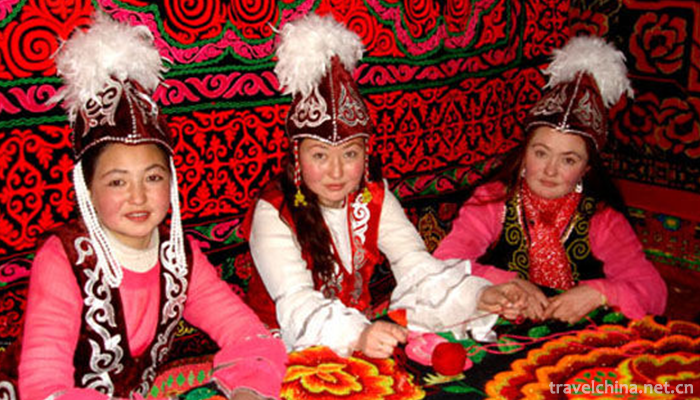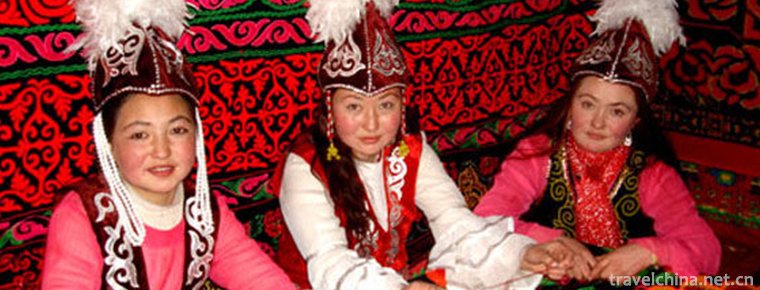Kirgiz embroidery

Kirgiz embroidery
Kirgiz embroidery is a traditional embroidery in Wensu County, Xinjiang Uygur Autonomous Region, China. Kirgiz women are good at embroidery. They embroider various delicate patterns on headscarves, pillows, quilts, sleeves, horsewear and hanging cloth decorations, including flowers, birds, animals and various geometric patterns. Bright colors and vivid images.
In 2008, Kirgiz embroidery declared by Wensu County of Xinjiang Uygur Autonomous Region was listed in the second batch of national intangible cultural heritage list with the approval of the State Council.
historical origin
Kirgiz embroidery has a long history and is closely related to the Central Plains culture. In the tombs of the Western Han Dynasty excavated in the Yenisai River Basin, woolen fabrics with exquisite patterns of birds, animals and plants were unearthed. It is recorded that there are craftsmen specializing in weaving silk brocade in Kirgiz area of Yenisai River Basin. "History of the Yuan Dynasty, Shizubenji" records that in 1286 (to the twenty-third year of the Yuan Dynasty), the Yuan government "owed State Bureaus 56,139 pieces of craftsmen's yarn to blossom 132". For thousands of years, the tall Pamirs have never lost contact with the mainland of their motherland.
artistic characteristics
style
They weave tapestries and carpets with exquisite patterns. Flower felt, white felt hat, silver saddle, wooden bowl, box, etc., exquisite and beautiful, simple and durable. Red, blue and white are the main crafts, especially red is the most popular.
Kirgiz men's traditional clothing is white embroidered collar shirt, coat collarless long shirt "loops", cuffs with black cloth edge. The style of jacket is vertical collar and button collar. Belts are tied over the coat. Wear wide-legged pants, suitable for nomadic riding, women's clothing for the broad collarless, less than knee length, inlaid with silver buttons on the jacket. A pleated skirt with fur at the bottom or a pleated dress of various colors at the bottom. A shoulder made of leather or cloth. Kirgiz women are good at embroidery. They often embroider beautiful and delicate geometric patterns on the collar, sleeves and chest of clothes. The main colours are red, blue and white. Knitting also shows exquisite skills. Tapestries and carpets woven with dyed wool and camel hair, curtains and aprons woven with Achnatherum splendens and red willow branches are well known in the world.
pattern
Among the Kirgiz embroidery patterns, the mountain peaks have become an indispensable landscape. The mountains in the eyes of the Ko people are mostly snow-capped icebergs, holy and pure white. Under their hands, the peaks are embroidered into white, pure white triangles, which fluctuate along the collar, trousers feet, sleeves, or the top of the blankets and the edge pillows of the walls. Sometimes, triangles are black or red-green, black represents Tushan, red and green represents Hongshan and Qingshan.
Inheritance significance
This embroidery is of great significance in inheritance. It has bright colors, beautiful shapes and is generous and simple. They mostly adopt flower and plant, birds and animals, sun, moon and stars and other patterns and geometric figures, the color is mainly black, white, red, blue, green and other basic tones. Different colors mean different meanings: black means deep and broad, indomitable and simple; blue is regarded as sacred and noble color with the sky; red means joy, warmth and happiness; green symbolizes spring and vitality. Kirghiz people are fond of white, because white can cause the moon, flour, cotton, milk and other beautiful things of rich association, but also pure, sincere implications. Every color in nature has been endowed with profound implications by Kirgiz.

-
1.Eight Immortals Crossing the Sea Scenic Area
Eight Immortals Crossing the Sea Scenic Area, also known as Eight Immortals Crossing the Sea and Eight Immortals Crossing the Haikou, is situated on the shore of the North Yellow Sea in Penglai City
Time 2018-12-23 -
2.Ordos Cultural Tourism Village
Ordos Cultural Tourism Village is located in the front banner of Etok, Ordos City. It is located in the western Ordos grassland at the junction of Mengning and Ningxia. It is located in the beautiful
Time 2019-01-08 -
3.Zizhuyuan Park
Zizhuyuan Park is located in the West Third Ring of Beijing, near Baishiqiao in Haidian District, west of Beijing Capital Stadium. Zizhuyuan Park was built in 1953. It was named for the Ming and Qing
Time 2019-03-22 -
4.GUI Opera
Gui Opera (commonly known as Gui Opera or Gui Ban Opera), Guangxi local traditional drama, one of the national intangible cultural heritage.
Time 2019-05-02 -
5.Horqin Chaoer Epic
Horqin epic is a local tradition of Mongolian heroic epic. It is the only living epic in Horqin area of Inner Mongolia Autonomous Region. "Chao Er Playing Method", "Overtone Playing Met
Time 2019-05-09 -
6.Manas
Manas, the traditional folk literature of Kirgiz Autonomous Prefecture in Kizlesu, Xinjiang, is one of the national intangible cultural heritage.
Time 2019-05-16 -
7.Brewing Techniques of Maotai Liquor
Maotai liquor brewing technology, the local traditional handicraft technology of Maotai Town, Zunyi City, Guizhou Province, is one of the national intangible cultural heritage.
Time 2019-05-29 -
8.Miao Sister Festival
Miao Sister Festival, also known as "Sister Rice Festival", is a traditional festival of Miao people in Laotun and Shidong areas of Taijiang County, Guizhou Province. It is held from March 1
Time 2019-06-05 -
9.Mantis Boxing
Mantis boxing is one of the famous Chinese traditional Wushu schools, and it is a kind of hieroglyphic boxing. It is one of the four famous boxing in Shandong Province and one of the first nine school
Time 2019-06-18 -
10.Stir fried pork with salted vegetables
Stewed pork with dried plum is a famous traditional flavor dish in Shaoxing, Zhejiang Province. The main raw materials are dried plum and streaky pork. Dried vegetables absorb meat fat to remove astri
Time 2020-03-18 -
11.Neijiang medical and health
By the end of 2019, there are 3303 medical and health institutions in Neijiang, including 76 hospitals (56 private hospitals) and 3200 primary medical and health institutions. There are 25900 beds in medical and health institutions and 21100 health technical personnel,
Time 2020-12-16 -
12.Meishan scenic spot
Meishan has a long history and culture and many cultural relics. Meishan County, where the municipal government is located, has a history of 1505 years. It is a famous town of Sansu culture. There are 2 provincial cultural relics protection unit
Time 2020-12-18